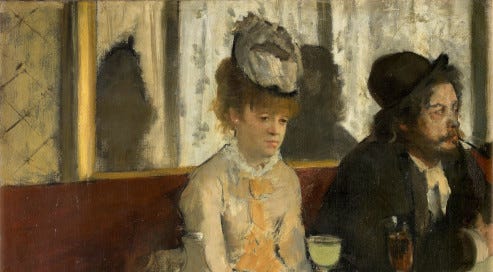Code of Health
no one had been there to teach her that rebellion was — first and foremost — an aesthetic
The blue puffer jacked drapes on the chair opposite her as a slight of hand. A way to distract the inattentive spectator into believing she is at dinner with a partner, perhaps taking their time in the restroom downstairs. The two plates of food help signal the fallacy, a heap of oil-slick Chinese noodles piled in a stack that would take a more chaste consumer two or three sittings to down. But the coat is her own. If the other diners cared, they would have figured it out by now. Too much time elapsed for a partner to emerge from the sooty basement, the bathroom decidedly worthy of the green “B” rating hung despondently in the upper corner of the sidewalk-facing window.
The lonesome woman spends the whole forty minutes of her solo meal scrolling unintentionally on her phone, going through the usual feed, pictures of acquaintances from her hometown, those who remained unpolluted by city life. Married with kids. If they question their normativity their plaster-cast smiles do a good job betraying the fact. She’d been skeptical of those traditional expectations growing up, trapped by their narrowing constraints, the tunnel of tyranny bringing societal prescriptions closer and closer to her growing head. Each pencil mark on the doorframe of her childhood bedroom signaling she was one inch closer to domestic desolation.
She’d been deemed rebellious by her family (though the nature of the rebellion mainly consisted of a closed bedroom door, an angsty reclusion into the music and movies that spoke to her, a refusal to smile and participate actively in the frequent social events her parents forced her to attend. She wasn’t antagonistic in a manner that demanded pointed concern and intervention. The only intersessions made to correct for her boisterous solitude had been the insistent, yet subtle chastisements at meal times. Are you sure all that alone time is good for you honey? The pastor says there’s a fun, young event in town this week… Why don’t you go with some friends? When friends were invoked, the proceeding word would seldom be possessive. Always some, never yours.)
She’d been naive to believe that her cloistered rebelliousness would translate to the rebelliousness inherent to New York City, where she’d decided to move to devalue her values (and where she found a job she could put her chronic digital disposition to work). In the city she suddenly appeared to others, and in turn herself, like a model vision of deference. Bending to bolster the order of things as they were. She wore pastel colored sweaters with pearls in the lattice threads. No one had been there to teach her that rebellion was — first and foremost — an aesthetic. A set of rules and regulations that required tactical maintenance, since the terms were ambiguously dictated by those who believed themselves to be “anti-establishment.” With no centralized authority to crack the whip, one needed to constantly monitor the direction of the counter-cultural winds.
The codes of the rebels were therefore always a matter of negation. Choosing what to be by establishing what not to be: artificial, both of character and expression (her polyester sweater an automatic disqualifier, that is, of course, had it been black), neat around the edges, trim, so to speak (again her sweater, crew in neck, was outside the regulation).
What did she have to show for her grand leap of faith? How to account for the fact she now felt a tang of longing for the moral framework of her upbringing — a feeling somehow more pungent than the Sichuan peppercorn lodged in her throat? Had it meant she’d failed? That she’d have been better off refusing to indulge the naive fabulations nurtured behind her closed door? Would she have been satisfied eating Panda Express in her suburban enclave if she had someone to do it with?
She got the check and left, plates licked clean, thankful she was spared the agony of splitting the bill.
If she paid the price, at least she could afford to do it on her own.



